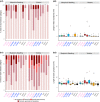Characterization of the pathogenicity of strains of Pseudomonas syringae towards cherry and plum
- PMID: 29937581
- PMCID: PMC5993217
- DOI: 10.1111/ppa.12834
Characterization of the pathogenicity of strains of Pseudomonas syringae towards cherry and plum
Abstract
Bacterial canker is a major disease of Prunus avium (cherry), Prunus domestica (plum) and other stone fruits. It is caused by pathovars within the Pseudomonas syringae species complex including P. syringae pv. morsprunorum (Psm) race 1 (R1), Psm race 2 (R2) and P. syringae pv. syringae (Pss). Psm R1 and Psm R2 were originally designated as the same pathovar; however, phylogenetic analysis revealed them to be distantly related, falling into phylogroups 3 and 1, respectively. This study characterized the pathogenicity of 18 newly genome-sequenced P. syringae strains on cherry and plum, in the field and laboratory. The field experiment confirmed that the cherry cultivar Merton Glory exhibited a broad resistance to all clades. Psm R1 contained strains with differential specificity on cherry and plum. The ability of tractable laboratory-based assays to reproduce assessments on whole trees was examined. Good correlations were achieved with assays using cut shoots or leaves, although only the cut shoot assay was able to reliably discriminate cultivar differences seen in the field. Measuring bacterial multiplication in detached leaves differentiated pathogens from nonpathogens and was therefore suitable for routine testing. In cherry leaves, symptom appearance discriminated Psm races from nonpathogens, which triggered a hypersensitive reaction. Pathogenic strains of Pss rapidly induced disease lesions in all tissues and exhibited a more necrotrophic lifestyle than hemibiotrophic Psm. This in-depth study of pathogenic interactions, identification of host resistance and optimization of laboratory assays provides a framework for future genetic dissection of host-pathogen interactions in the canker disease.
Keywords: Pseudomonas; non‐host; pathogenicity; resistance.
Figures










References
-
- American Pomological Society , 1966. Merton cherries from England. Journal of Fruit Varieties and Horticultural Digest 20, 46.
-
- Andrews S, 2010. FastQC: A quality control tool for high throughput sequence data. [http://www.bioinformatics.babraham.ac.uk/projects/fastqc]. Accessed 12 December 2017.
LinkOut - more resources
Full Text Sources
Other Literature Sources
Miscellaneous
